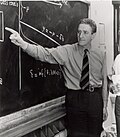This is a list of Welsh mathematicians, who have contributed to the development of mathematics.
| Name | Image | Born | Died | Notes |
|---|---|---|---|---|
| Brian Bowditch | 1961 [1] Neath | n/a | Known for his contributions to geometry and topology, particularly in the areas of geometric group theory and low-dimensional topology. He is also known for solving the angel problem. Bowditch holds a chaired Professor appointment in Mathematics at the University of Warwick. | |
| George H. Bryan |  | 1 Mar 1864 [2] Cambridge | 13 Oct 1928 [2] Bordighera | Credited with developing the modern mathematical treatment of the motion of airplanes in flight. In 1888, Bryan developed mathematical models for fluid pressures within a pipe and for external buckling pressures. These models are still used today. Aside from minor differences in notation, Bryan's 1911 equations are the same as those used today to evaluate modern aircraft. Born at Cambridge, he was Professor of Mathematics at Bangor University 1896 till 1928. [3] |
| Griffith Davies |  | 5 Dec 1788 [4] [5] Llandwrog [4] [5] | 25 Mar 1855 [6] [7] [5] Islington [5] | Noted actuary and author, born in Llandwrog, Caernarfon. Fellow of the Royal Society. [8] |
| Lancelot Hogben | 9 Dec 1895 [9] [10] [2] Portsmouth | 22 Aug 1975 [9] [10] [2] Wrexham | Medical statistician, founder of the Society for Experimental Biology, and author of Mathematics for the Million (1936). Learnt Welsh and lived and died in Glyn Ceiriog, Wrexham, Wales. [3] | |
| William Jones |  | 1675 [11] [12] [7] Llanfihangel Tre'r Beirdd [4] | 1 Jul 1749 [12] [13] London [14] | Born in Anglesey in 1675, was the first recorded mathematician to use the symbol π in its present sense in 1706, though it would not achieve widespread adoption until used by famed Swiss mathematician Euler. |
| Thomas Jones |  | 23 Jun 1756 [2] Berriew | 18 Jul 1807 [2] Edgware Road | Senior Wrangler and Senior Tutor of Trinity College, Cambridge. [15] |
| John T. Lewis |  | 15 Apr 1932 [16] Swansea [16] | 21 Jan 2004 [16] Dublin [16] | Contributed to quantum measurement, Bose–Einstein condensation and large deviations theory. |
| William Morgan |  | 26 May 1750 [17] [2] [18] Bridgend [19] [20] [18] | 4 May 1833 [18] London [17] | Considered the father of modern actuarial science. |
| Richard Price |  | 23 Feb 1723 [2] [21] [22] Llangeinor [23] | 19 Apr 1791 [2] [22] [21] Newington Green [23] | Wrote a paper on the proper method of calculating the values of contingent reversions which were said to have exercised a beneficial influence in drawing attention to the inadequate calculations on which many insurance and benefit societies had recently been formed. In 1769 Price received the degree of D.D. from the university of Glasgow for this work. He also wrote on finance, economics, probability, and life insurance. Price edited Bayes's major work An Essay towards solving a Problem in the Doctrine of Chances (1763), which contains the Bayes' Theorem with an introduction to the paper which provides some of the philosophical basis of Bayesian statistics. In 1765 he was elected a Fellow of the Royal Society in recognition of his work on the legacy of Bayes. |
| Robert Recorde |  | 1510 [24] [25] [26] Tenby [4] | 1558 [27] [24] [28] London [24] [28] [29] | Sixteenth-century inventor of the equals sign was from Tenby. As it has been suggested, "[h]is equals sign was an invention that, while slow in becoming universally adopted, is still perhaps the most fundamental thing ever invented by a Welsh person." [30] . |
| Elmer Gethin Rees |  | 19 Nov 1941 [31] Llandybie | 4 Oct 2019 [32] Bristol | A Welsh mathematician and Director of the Heilbronn Institute for Mathematical Research from its creation in 2005 until 2009. |
| Bertrand Russell |  | 18 May 1872 [33] [34] [35] Trellech [36] | 2 Feb 1970 [33] [37] [34] Plas Penrhyn [36] , Penrhyndeudraeth [36] | Influential British thinker of the twentieth century, though more properly a philosopher than a mathematician, was of English descent but born in Monmouthshire. |
| Neil Sloane |  | 10 Oct 1939 [2] Beaumaris | Neil James Alexander Sloane FLSW has had major contributions in combinatorics, error-correcting codes, and sphere packing. He is perhaps best known for being the creator and maintainer of the On-Line Encyclopedia of Integer Sequences (OEIS). [38] | |
| Mary Wynne Warner | 22 Jun 1932 [39] Carmarthen [4] | 1 Apr 1998 [39] Spain [4] | 'Pioneer' in fuzzy mathematics, born in Carmarthen. |